As an Amazon Associate, I earn from qualifying purchases with no additional costs for you.
With diverse landscapes and treasure troves of unique rocks and minerals, it’s no wonder that New Mexico is on every rockhound’s itinerary. If you want to collect rare rocks, precious gems, or fascinating fossils from the Land of Enchantment, continue on and delve into this New Mexico rockhounding guide.
The Land of Enchantment has many rocks and minerals for rockhounds, including:
- fire agate,
- meteorite,
- Apache Tears,
- petrified wood,
- fossils,
- red beryl,
- turquoise,
- opal,
- Pecos Diamond,
- azurite,
- and peridot.
While it’s true that New Mexico has plenty of rocks and minerals, finding them without any prior research or information can prove to be challenging. Set yourself up for success and learn everything you need to know about New Mexico rockhounding in this overview.
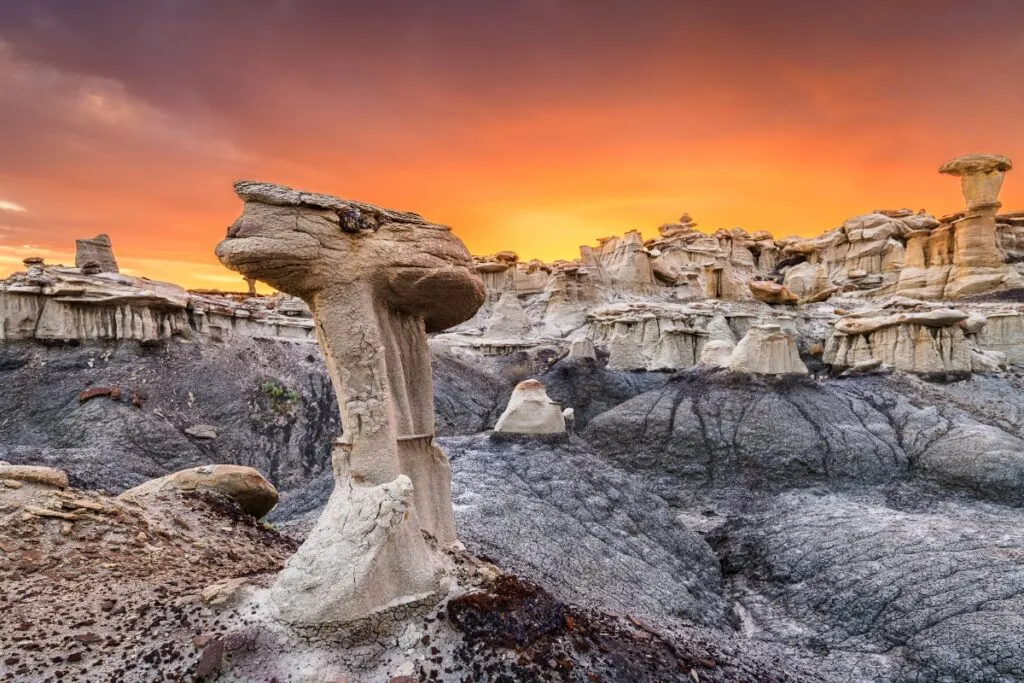
If you are interested in checking out the best rockhounding tools you can find them by clicking here (Amazon link).
What Rocks Are Found in New Mexico
Some truly enchanting rocks that you might come across in the Land of Enchantment are:
Fire Agate

| Location | GPS Coordinates |
|---|---|
| Santa Fe Mountains | 35.799371, -105.517366 |
| Mimbres Mountains | 32.842914, -107.732810 |
| San Francisco River | 33.344903, -108.910201 |
| Mud Springs Mountains | 33.163457, -107.302276 |
| Abiquiu Lake | 36.239757, -106.429970 |
| Pyramid Mountains | 32.191351, -108.721552 |
With fiery orange, red, brown, and gold hues, fire agates truly do their name justice, and you can find these rare agates right here in New Mexico.
These agates are typically millions of years old, and contrary to popular belief, you don’t need to visit old mines to find them. In the Land of Enchantment, you can collect fire agates just about anywhere, from mountain trails to cave chasms.
In addition to fire agates, rockhounds also bring home gem-quality banded and moss agates from this state.
The mountain ranges of New Mexico are some of the top places to find agates in the state. Check out the Santa Fe Mountains, Mimbres Mountains, and Mud Springs Mountains for gem-quality agates.
Meteorite
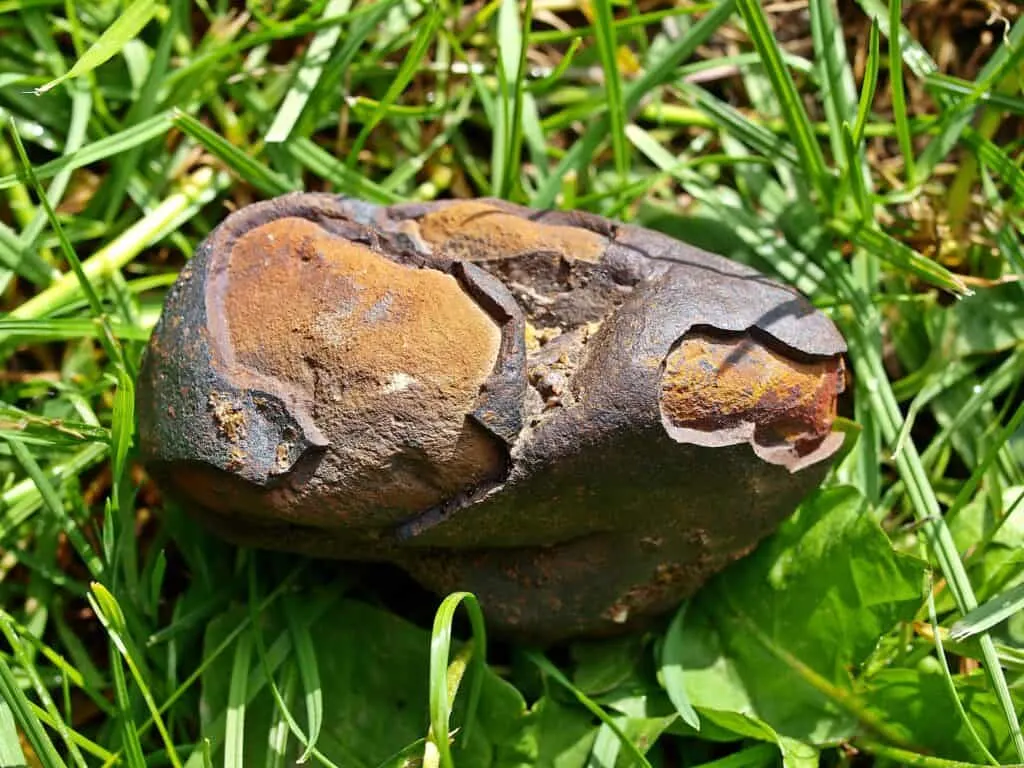
| Location | GPS Coordinates |
|---|---|
| Roosevelt County | 34.222204, -103.760223 |
| Glorietta Mesa | 35.572607, -105.770065 |
| Portales Valley | 34.102398, -103.051228 |
| Albuquerque | 35.158681, -106.816573 |
| De Baca County | 34.387827, -104.301299 |
| Chaves County | 33.695963, -104.367217 |
Although rocks from earth are neat, who wouldn’t want rocks from space? Meteorites are notoriously difficult to find, but fortunately, New Mexico is full of them. These meteorites form in all shapes and sizes, and one rockhound even found a 2-pound meteorite in New Mexico!
Roosevelt County, De Baca County, and Chaves County are three great areas for finding meteorites. A 2-pound meteorite was found near Albuquerque, so that area might be worth a look as well.
TIP: Moon rocks are cosmic treasures that come in shades of white and grey, encompassing a variety of rock types such as basalts, breccias, and plutonic rocks sourced from the lunar highlands.
Moon Rocks: Everything You Need to Know About Them
Apache Tears
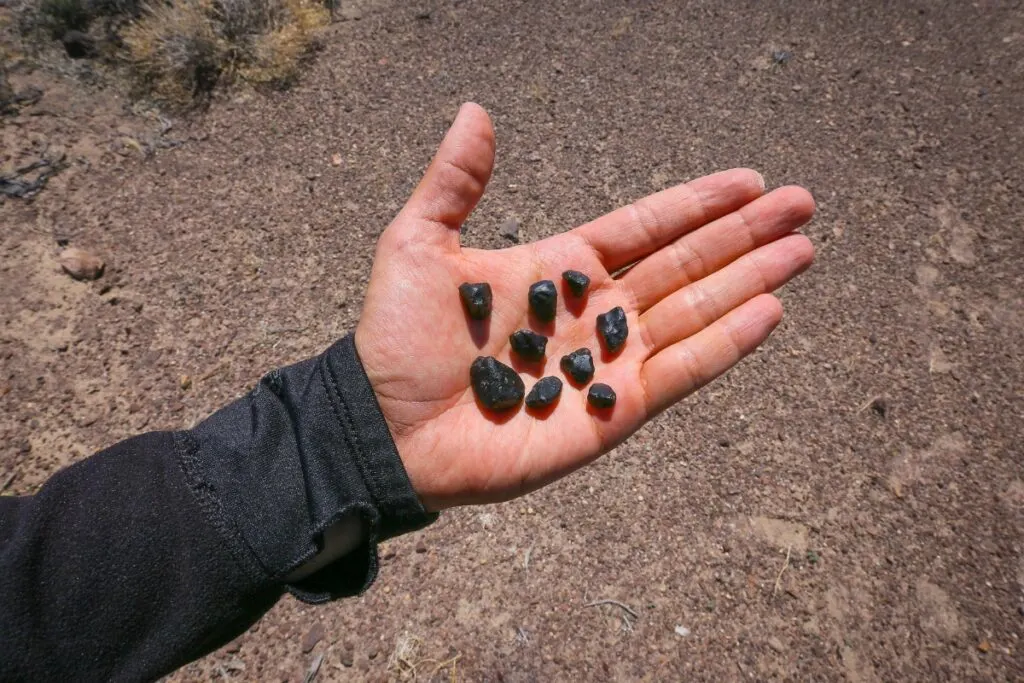
| Location | GPS Coordinates |
|---|---|
| Santa Fe National Forest | 35.940897, -106.275698 |
| Los Lunas | 34.804186, -106.778534 |
| Mule Creek | 33.121650, -108.955402 |
| Grants | 35.141640, -107.844847 |
| Rio Grande | 34.820374, -106.715079 |
| Los Alamos County | 35.946409, -106.283607 |
Although there are many U.S. states that contain obsidian, there are very few that contain Apache Tears, a unique form of this rock. Apache Tears are droplets of obsidian that resemble tears, and New Mexico specimens are often buried in pyrite.
According to legend, these obsidian droplets are the tears of the Apache people who mourned the losses of their warriors. Due to their unique shape, Apache Tears are valued among collectors, and they mainly exist in the western states.
Collect Apache Tears near the Santa Fe National Forest, Los Lunas, or Mule Creek. Grants and the Rio Grande are some additional areas that are known for Apache Tears.
Petrified Wood
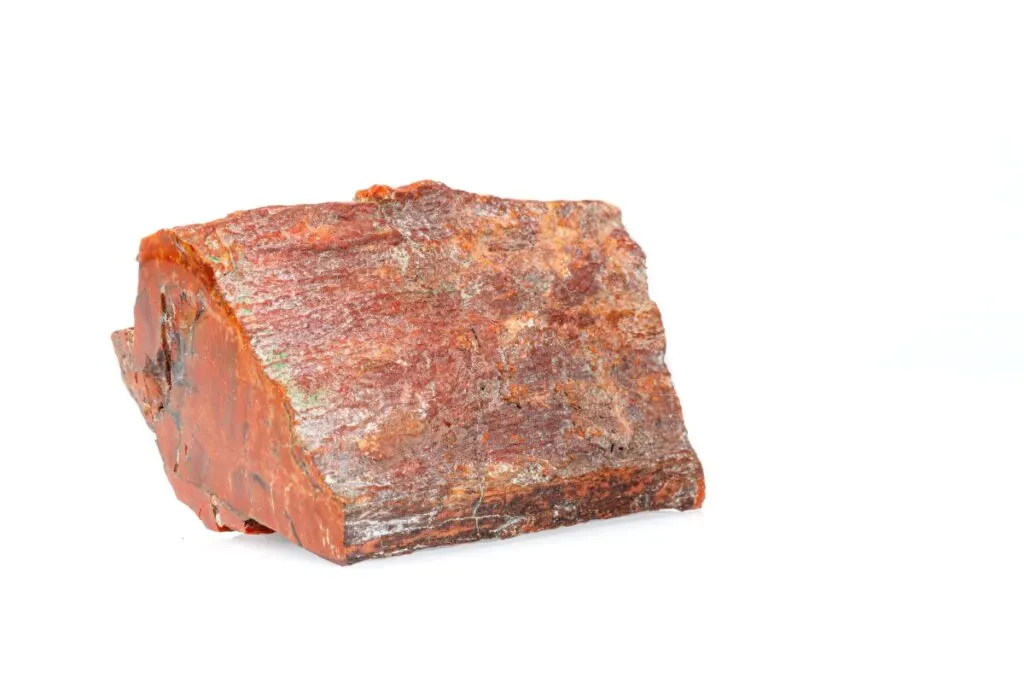
| Location | GPS Coordinates |
|---|---|
| San Juan County | 36.440905, -107.783395 |
| Union County | 36.465304, -103.503192 |
| Las Vegas | 35.587766, -105.205825 |
| Mount Chalchihuitl | 35.469894, -106.112908 |
| Zuni Mountains | 35.167319, -108.316908 |
| Jornada Valley | 33.136242, -107.024579 |
| Rio Puerco Valley | 35.075430, -106.948893 |
| Mud Springs Mountains | 33.163457, -107.302276 |
It’s true that there isn’t a large petrified forest in New Mexico, but rockhounds do discover pieces of petrified wood in various areas of the state. As a matter of fact, petrified wood is present in 15 of New Mexico’s 32 counties. In addition to petrified wood, rockhounds also come across opalized wood in certain regions, but it is more difficult to find.
Visit San Juan County, Union County, and Jornada Valley for high-quality pieces of petrified wood. For opalized wood, swing by the Rio Puerco Valley or Mud Springs Mountains.
TIP: Demand for natural petrified wood created the appearance of numerous fakes. Check out differences between real and fake petrified wood in the article below:
Real vs. Fake Petrified Wood: Focus on These 10 Differences
Fossils
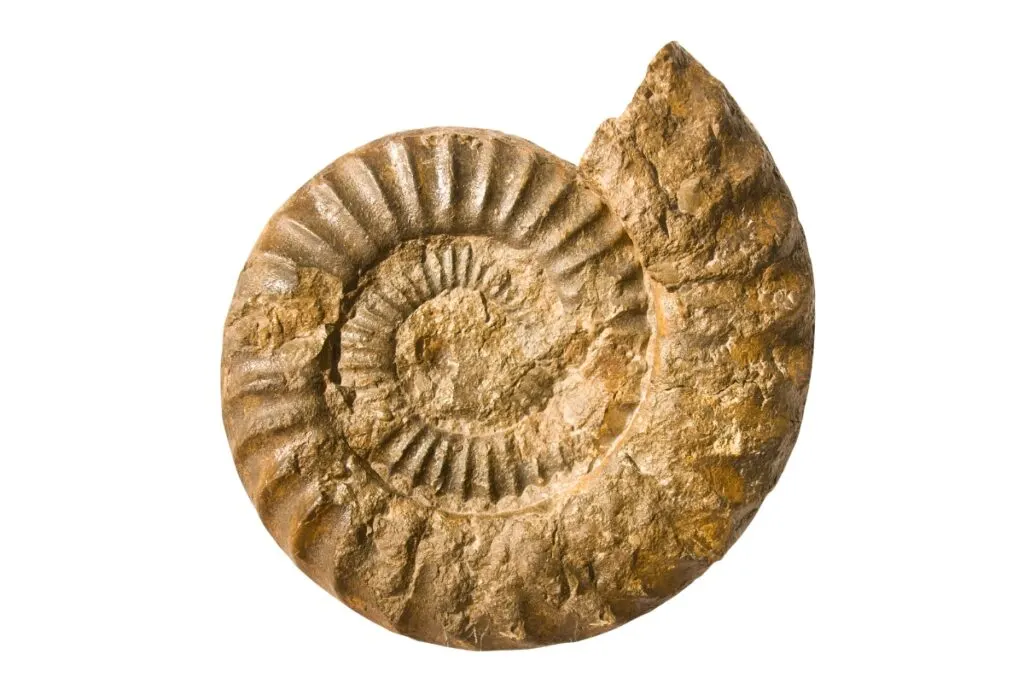
| Location | GPS Coordinates |
|---|---|
| Kelly Ghost Town | 34.068553, -107.194189 |
| Zuni Mountains | 35.167459, -108.316779 |
| Mount Chalchihuitl | 35.469894, -106.112908 |
| Red Rock Spring | 34.353110, -107.307624 |
| Santa Fe | 35.799649, -105.517324 |
| Cabezon | 35.599485, -107.096082 |
Did you know that New Mexico has a fossil forest? This forest has many deposits of petrified wood and other fossils.
One important rule to note in New Mexico is that it is legal to collect invertebrate fossils but not vertebrate fossils. The Land of Enchantment possesses sea creatures, land animals, and even dinosaur fossils and tracks, so you never know exactly what to expect from this state.
Stop by the Zuni Mountains, Mount Chalchihuitl, or the mines in Kelly Ghost Town for all sorts of fossils.
Recommendation box: All tools and equipment you need for rockhounding and rock identification* (Amazon links):
1. Estwing Rock Hammer – Light, comfortable, and extremely durable hammer.
2. Estwing Geologist Pick – Classic and the most trusted paleo pick in the world.
3. Finder 12-inch Chisels – Heavy-duty chisels set with hand protection.
4. Mini Handle Shovel – This is a great tool for digging deep in the dirt.
5 Ironclad Utility Work Gloves – Breathable, but they also protect the areas requiring them most.
6. 3M Safety Glasses – Comfortable and efficient goggles for rockhounding.
7. Convoy 8+ UV Light – 365nm UV LED flashlight with a patented glass filter.
8. Wesley’s Jewelers Loupe – High magnification options (30X and 60X) with carrying case.
9. Mohs Hardness Kit – A specially designed kit for rockhounds
*All recommended products are personally tested and regularly used by experts from this website.
What Minerals Are Found in New Mexico
From glittering azurite to sparkling Pecos Diamonds, rockhounds uncover all sorts of minerals in New Mexico, such as:
Red Beryl
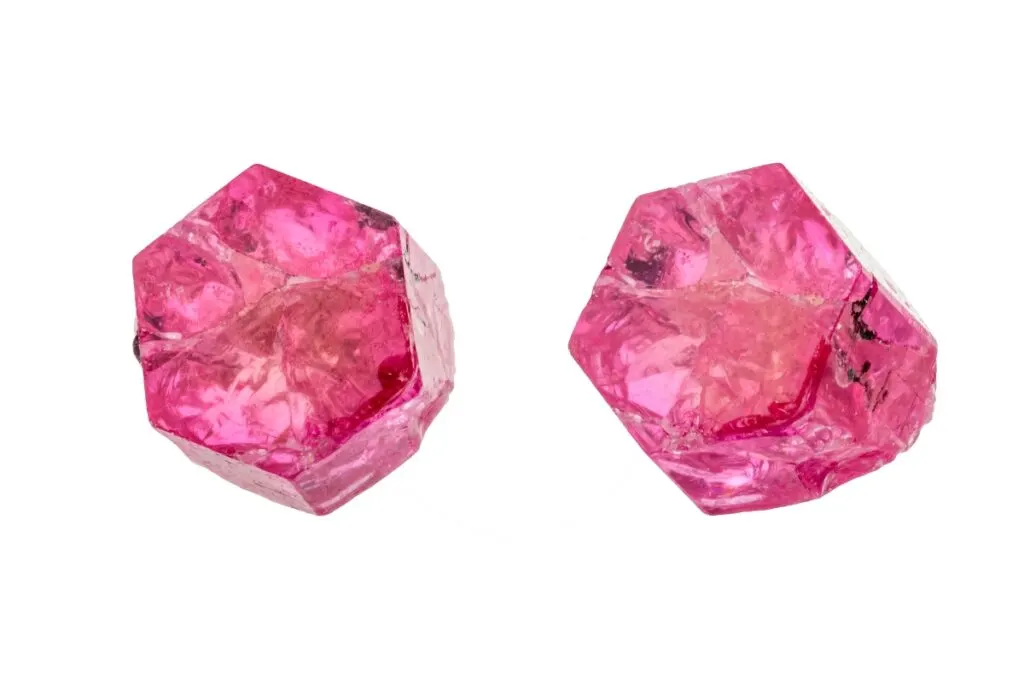
| Location | GPS Coordinates |
|---|---|
| Paramount Canyon | 33.413597, -107.959792 |
| Sunnyside Mine | 36.453891, -106.049334 |
| Sierra County | 33.218209, -107.137907 |
| Round Mountain | 33.148551, -105.883729 |
| Petaca | 36.507868, -106.010145 |
| Grant County | 32.680521, -108.454643 |
Did you know that red beryl is one of the rarest minerals on earth? Fortunately, one of the places that meets the specific geological requirements for red beryl is New Mexico, so rockhounds have the opportunity to find it in this state.
Compared to the red beryls from Utah, the ones from New Mexico are generally smaller and lighter, but still amazing finds nonetheless.
Grant County and Sierra County are two areas where red beryl exists. Search near Paramount Canyon and Round Mountain for pieces of this red gem.
Turquoise
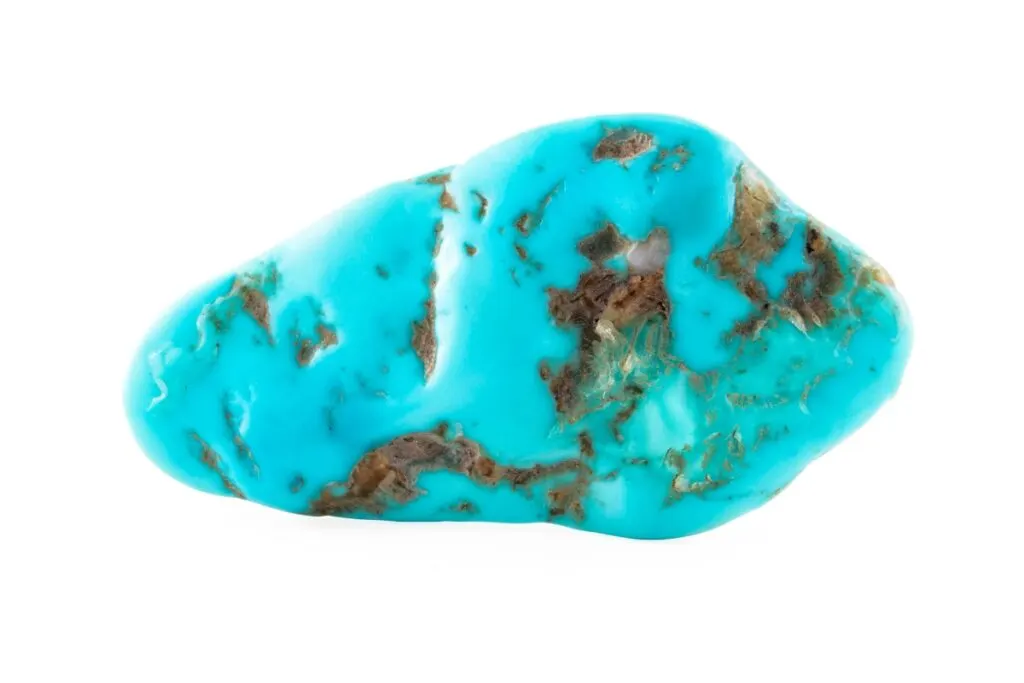
| Location | GPS Coordinates |
|---|---|
| Otero County | 32.672968, -105.879283 |
| Santa Fe County | 35.675699, -106.037680 |
| Dona Ana County | 32.237855, -106.889060 |
| Socoro County | 33.932886, -107.092404 |
| Grant County | 32.678209, -108.454643 |
| Hidalgo County | 31.866380, -108.784352 |
| Lincoln County | 33.694432, -105.429241 |
Turquoise exists in 7 out of New Mexico’s 33 counties. Although turquoise might not be present in many of New Mexico’s counties, the specimens found in this state are of exceptional quality. Additionally, it is fairly plentiful in the 7 counties, so rockhounds have a shot at collecting it.
Swing by the Otero County, Santa Fe County, and the remaining 5 counties listed above to collect New Mexico turquoise.
TIP: Fake turquoise was already known to ancient Egyptians who used blue glass or ceramic to imitate robin’s-egg blue valuable gemstone. Find out more in the article below:
Real vs. Fake Turquoise: Check Out These 11 Key Differences
Opal
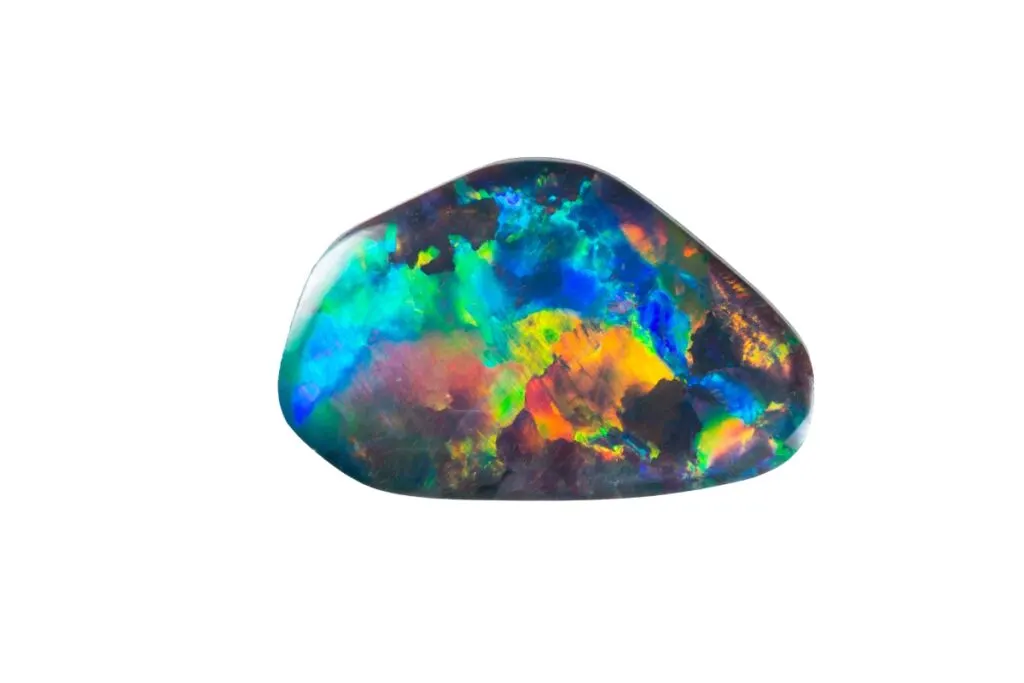
| Location | GPS Coordinates |
|---|---|
| Big Hatchet Mountains | 31.614831, -108.363394 |
| Fort Bayard | 32.795500, -108.150322 |
| Isleta Pueblo | 34.906679, -106.680515 |
| Deming | 32.263086, -107.742290 |
| Rockhounding State Park | 32.185793, -107.612230 |
| Rio Puerco | 34.372730, -106.842226 |
You can uncover many types of opals in the Land of Enchantment, including common, fire, and moss opals. New Mexico opals are not as common as opals in other states, but high-quality stones exist in certain areas.
The Big Hatchet Mountains, Isleta Pueblo, and Rockhounding State Park are three of the top sites for opals in New Mexico.
Pecos Diamond
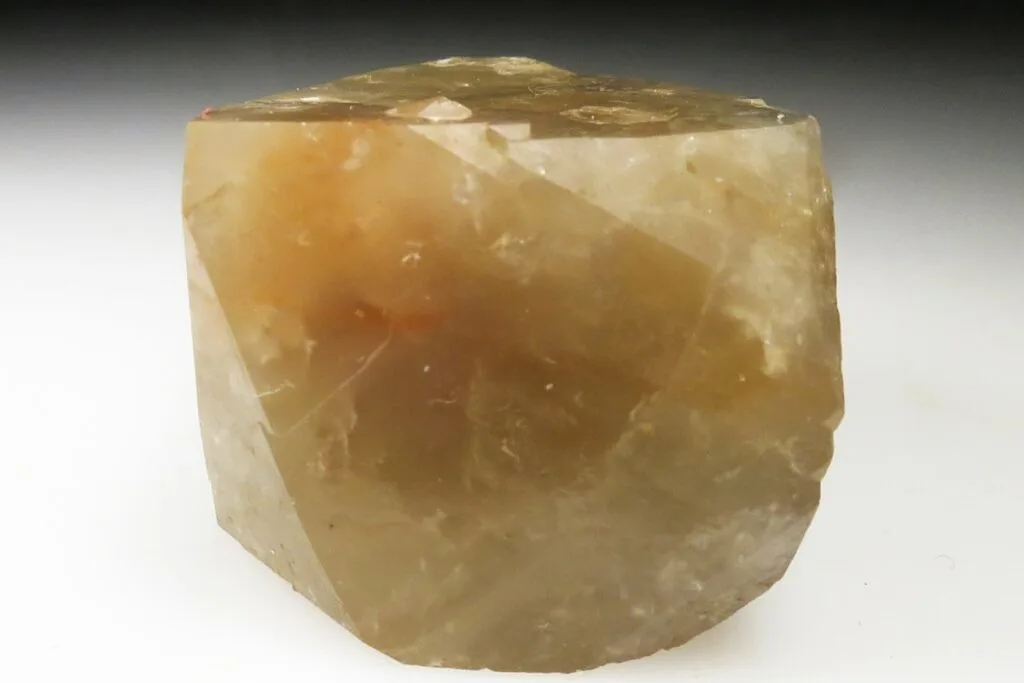
| Location | GPS Coordinates |
|---|---|
| Pecos River | 33.036299, -104.269926 |
| Artesia | 32.844022, -104.394724 |
| Seven Rivers | 32.594643, -104.421328 |
| Mosaic Mine | 32.409839, -103.942401 |
| Eddy County | 32.560908, -104.357244 |
| Fort Sumner | 34.466553, -104.245675 |
While Pecos Diamonds aren’t actually composed of diamond, they are unique and rare finds. These stones are comprised of double-terminated quartz crystals, and they often appear in orangish-red colors. New Mexico is the only U.S. state where these crystals exist, so they are a special find for any rockhound.
These unique quartz crystals wash up all along the shores of the Pecos River. The Seven Rivers area is also a well-known area for these stones.
TIP: Rockhounding in the desert might not seem rewarding at first. However, there are many rocks, minerals, and gemstones that you can find if you know where to look for. Find out more below:
Rockhounding in Desert: How to Find + 5 Best Places in the USA
Azurite
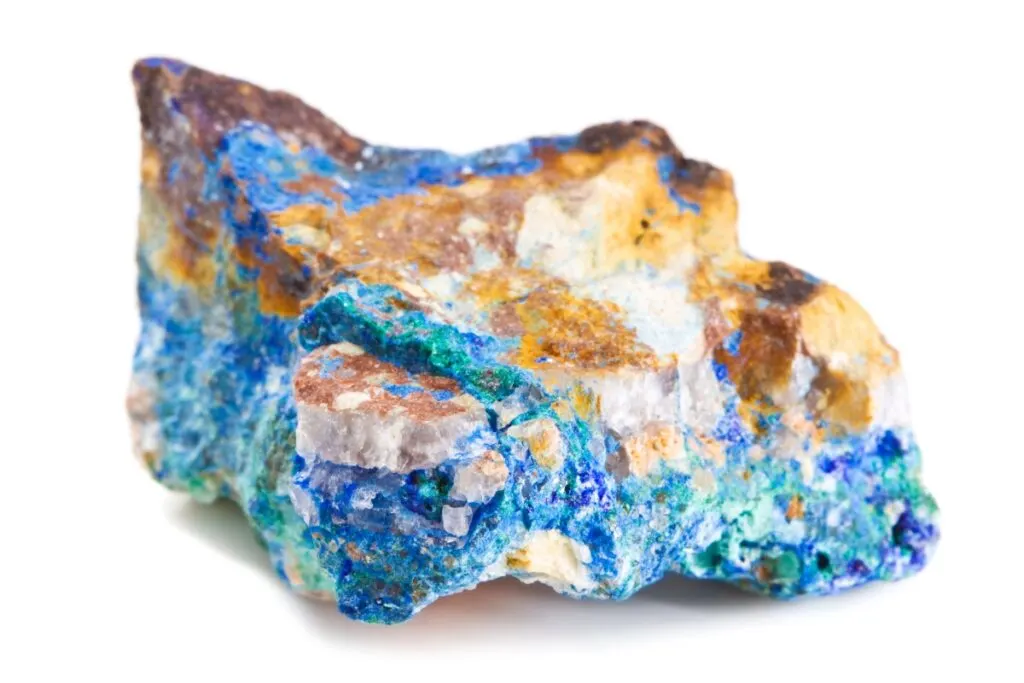
| Location | GPS Coordinates |
|---|---|
| San Pablo | 32.248495, -106.772349 |
| Grant County | 32.511601, -108.336540 |
| Socorro County | 33.973894, -107.062191 |
| San Miguel County | 35.365065, -105.325352 |
| Quay County | 35.320748, -103.522524 |
| Nacimiento Mountains | 36.032483, -106.854268 |
With the largest open copper pit mine in the world in Santa Rita, it’s no wonder that New Mexico has plenty of copper minerals, such as azurite. If you’re a fan of this stunning blue crystal, New Mexico has more than enough of it for rockhounds to gather.
Check out Grant County, Socorro County, and San Miguel County for New Mexico azurite. Keep an eye out for other copper minerals as well, such as malachite or turquoise.
Peridot
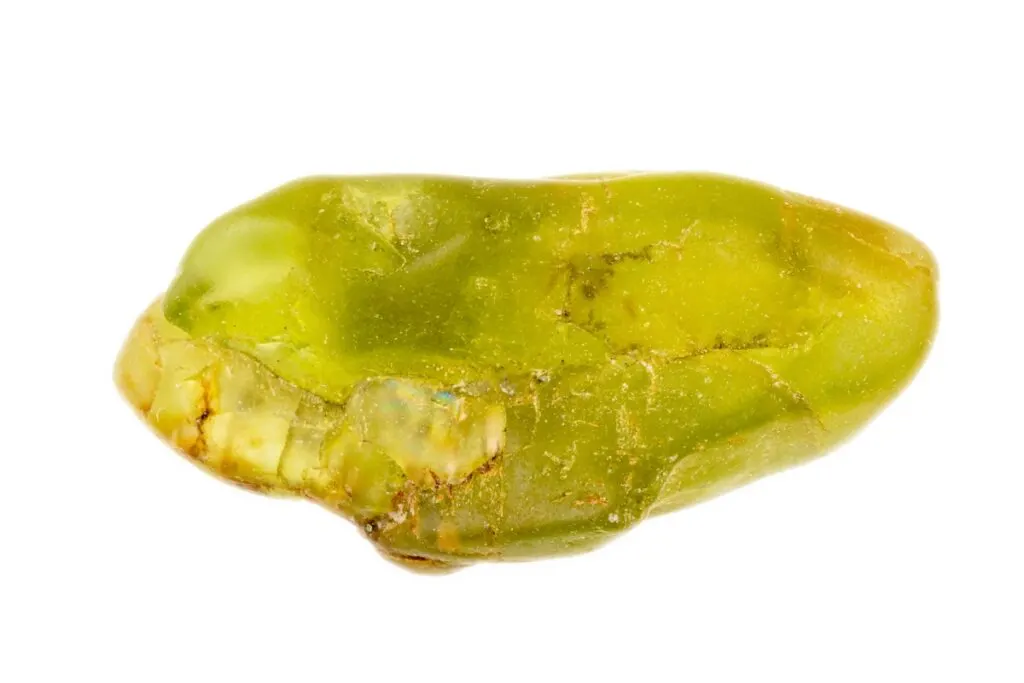
| Location | GPS Coordinates |
|---|---|
| Dona Ana County | 31.905035, -106.768210 |
| Kilbourne Hole | 40.949790, -73.920414 |
| Las Cruces | 32.337696, -106.735251 |
| Deming | 32.251793, -107.729514 |
| Radium Springs | 32.498482, -106.921438 |
| Rincon | 32.659213, -107.102864 |
Would you be surprised to find gem-quality peridots in New Mexico? Not many people know that there are plenty of peridots waiting for rockhounds in New Mexico. Peridots from the Land of Enchantment are known for their bright shine and rich green color, and many are gemstone-quality.
Dona Ana County is known for its peridots, and the best place to visit is Kilbourne Hole. Explore the basalt rocks of this area to find peridot and other collectible minerals.
TIP: New Mexico has many sites that can be generously described as a gold panner’s delight. Check out the complete prospecting guide in the article below:
Gold Prospecting in New Mexico: 7 Best Locations & Laws
FAQ About Common Rocks & Minerals in New Mexico
Dig deeper into the world of New Mexico’s rocks and minerals with the following FAQs:
What Rare Rocks Can You Find in New Mexico
Whether you want to collect rare, colorful stones or rocks that are not of this world, you’ll find exactly what you’re looking for and more in New Mexico.
Some popular rare rocks that exist in New Mexico are fire agates, meteorites, Apache Tears, petrified wood, opalized wood, jasper and fossils. From this list, the minerals that only exist in New Mexico and some of its surrounding states are fire agates, Apache Tears, and meteorites.
As you can imagine, these rare rocks are exceptional finds for rockhounds, especially since they exist solely in a few U.S. states.
Scroll up in this guide to learn more about these rare rocks in detail. The locations and coordinates for each of these rocks are revealed above as well.
What Rare Minerals Can You Find in New Mexico
In addition to rare rocks, New Mexico is also a great place to go for rare minerals, including red beryls, turquoises, opals, Pecos Diamonds, azurites, peridots, onyxes, aquamarines, garnets, tourmalines, vanadinites, amethysts, and gold.
The minerals that the Land of Enchantment is known for are red beryl, turquoise, and Pecos Diamonds. All these minerals are rare, but red beryl and the Pecos Diamond stand out from the rest since they only exist in a few other places in the world.
Fortunately, there are some counties in New Mexico where rockhounds can pick up multiple rare minerals at once. Dona Ana County, Santa Fe County, and Grant County should be your first stops for New Mexico gems.
What is the Most Famous Rock or Mineral Found in New Mexico
Despite the fact that Pecos Diamonds are extremely rare, red beryl is the most famous mineral found in New Mexico.
Red beryls are also extremely rare since they require specific geological conditions to form, and the ones from New Mexico show up in excellent condition. The crystals from this state are smaller and display lighter shades of red than the ones from Utah, but they are just as beautiful.
The Black Range, which runs between Grant County and Sierra County, has more red beryl than any other area in the state. Some specific sites to visit include Round Mountain and Paramount Canyon.
Conclusion
The Land of Enchantment has such an interesting array of rare rocks and minerals, so it’s easy to see why New Mexico a must-see destination for rockhounds.
During your visit, be sure to keep an eye out for fire agates, red beryls, Pecos Diamonds, meteorites, and the other fascinating stones discussed in this article.
While you might not be able to collect every single one of these rocks and minerals during your New Mexico adventures, even one or two of these stones will make your trip well worth your time!
TIP: Though New Mexico is a fantastic state to visit, especially for a rock collector, there are certain spots more worthy than others. Find out more in the article below:
Best Rockhounding in New Mexico: Where to Go & What to Find
